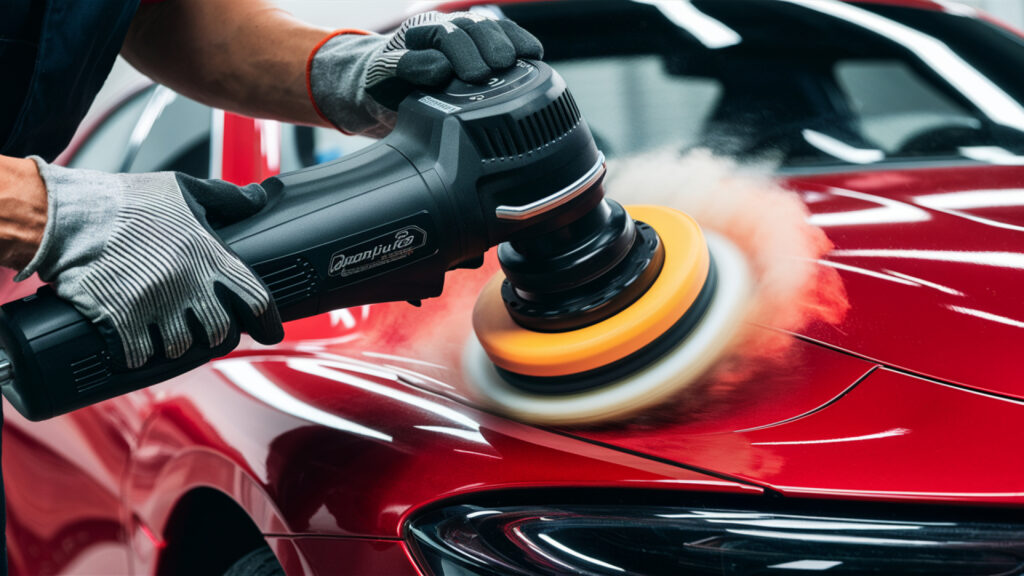In terms of versatility and safety, a dual-action orbital polisher is generally considered better than a rotary polisher. Orbital polishers are safer for beginners and less likely to cause paint damage.
Recommended Best Rotary Polisher 2025
| Recommendation | Product |
| Best Overall | DEWALT 20V MAX XR Rotary Cordless Polisher |
| Popular Choice | Milwaukee M18 18-Volt Brushless Cordless Polisher |
| Best Value | Makita 9237CX3 7″ Polisher |
| Best Budget | SPTA Rotary Polisher |
| Another Excellent Pick | PORTER-CABLE 7424XP Polisher |
When it comes to choosing the right polisher for your car, the decision between an orbital and a rotary polisher can be crucial. Both tools have their own advantages and disadvantages, so it’s important to understand the differences before making a decision.
Orbital polishers, also known as dual-action polishers, are popular among both professionals and car enthusiasts due to their versatility and ease of use. On the other hand, rotary polishers are known for their ability to remove heavy paint defects quickly. Understanding the strengths and limitations of each type of polisher will help you make an informed decision that suits your specific needs.

Introduction To Car Polishing
Comparing orbital and rotary polishers for car detailing reveals that orbital polishers are gentler on paint surfaces. They are ideal for beginners due to their user-friendly nature and versatility, while rotary polishers are more powerful and better suited for professional or heavy-duty applications.
The Role Of Polishers In Auto Detailing
Car polishers play a crucial role in maintaining a vehicle’s exterior.
They help remove imperfections, restore shine, and protect the paint.
Orbital Vs. Rotary Polishers: The Core Differences
Orbital polishers are beginner-friendly, while rotary ones are more powerful.
Orbital polishers are safer for inexperienced users.
Rotary polishers are better for experienced detailers for heavy correction.
Choose based on your experience level and detailing needs.
Orbital Polishers Explored
Delving into the world of car polishers, the debate between orbital and rotary options continues. While the orbital polisher is better for beginners due to its user-friendly nature and ability to prevent paint damage, the rotary polisher offers professionals more power and quicker results.
Both polishers have their strengths, catering to different needs.
How Orbital Polishers Work
Orbital polishers are a type of machine that uses circular motions to polish and buff surfaces. The polisher head moves in a random orbital pattern, which prevents swirl marks and holograms on the surface. The machine is lightweight and easy to use, making it a popular choice for both professionals and DIY enthusiasts. The pad on an orbital polisher oscillates in a back-and-forth motion, which allows it to evenly distribute polish and wax on the surface.
Pros Of Using An Orbital Polisher
One of the biggest advantages of using an orbital polisher is its versatility. It can be used for a variety of tasks, including polishing, waxing, and buffing. The random orbital pattern also means that there is less risk of damaging the surface, making it a safer option for beginners. Additionally, orbital polishers are generally more affordable than rotary polishers, making them a great option for those on a budget.
Cons Of Orbital Polishers
While orbital polishers are great for most tasks, they do have some limitations. One of the biggest drawbacks is the amount of time it takes to complete a job. Because the polisher head moves in a random pattern, it can take longer to achieve the desired results. Orbital polishers also have less power than rotary polishers, which means that they may not be suitable for heavy-duty jobs. Additionally, because the pads on an orbital polisher are softer, they may not be able to remove deep scratches or imperfections.
Rotary Polishers Demystified
When it comes to polishing your car or any other vehicle, it’s important to choose the right tool for the job. Two popular options for achieving that perfect shine are orbital polishers and rotary polishers. In this article, we will be demystifying rotary polishers, exploring their mechanics, benefits, and drawbacks.
Mechanics Of Rotary Polishers
Rotary polishers are powerful tools that operate by spinning a polishing pad in a circular motion. They use a direct drive system, where the pad is directly attached to the motor shaft. This design allows for high-speed rotation, typically ranging from 1,000 to 3,000 revolutions per minute (RPM).
The spinning motion of a rotary polisher generates a lot of heat and friction, which is ideal for removing heavy paint imperfections, scratches, and oxidation. However, this heat generation can also be a drawback if not used properly, as it can cause damage to the paint surface if the polisher is not handled with care.
Benefits Of Rotary Polishing
Rotary polishers offer several benefits that make them a popular choice among professional detailers:
- Efficiency: The high-speed rotation of a rotary polisher allows for quick and effective paint correction, making it suitable for heavily damaged or neglected surfaces.
- Versatility: Rotary polishers can be used with a variety of pads and compounds, giving you the flexibility to achieve different levels of paint correction.
- Aggressiveness: With their powerful spinning action, rotary polishers excel at removing deep scratches, heavy swirl marks, and other stubborn imperfections.
Drawbacks Of Rotary Polishers
Despite their many advantages, rotary polishers also have a few drawbacks to consider:
- Learning Curve: Mastering the technique of using a rotary polisher requires practice and skill. The high speed and aggressive nature of the tool can make it challenging for beginners.
- Potential Damage: Due to the intense heat generated and the risk of applying too much pressure, there is a higher chance of causing paint damage if the polisher is mishandled.
- Limited Finishing Ability: Rotary polishers are not known for providing a high level of finish. They are primarily designed for heavy correction and may leave holograms or buffer trails on the paint surface, requiring additional steps for a flawless finish.
Understanding the mechanics, benefits, and drawbacks of rotary polishers is essential when deciding which type of polisher to use for your specific needs. While rotary polishers offer power and efficiency for heavy paint correction, they may not be the ideal choice for beginners or those seeking a showroom-like finish. Consider your skill level and desired results before making your polishing tool selection.
Comparative Analysis
When deciding between an orbital or rotary polisher, it’s crucial to conduct a comparative analysis to determine which option best suits your needs. This involves assessing their performance on different surfaces, ease of use for beginners, and potential for paint damage.
Performance On Different Surfaces
Orbital polishers are effective for light to moderate paint correction, making them ideal for beginners and enthusiasts. On the other hand, rotary polishers are better suited for professionals and experienced users due to their ability to tackle heavy defects and achieve a more aggressive cut.
Ease Of Use For Beginners
For beginners, an orbital polisher is the preferred choice due to its user-friendly nature. Its random orbit movement minimizes the risk of swirl marks and burn-through, making it forgiving for inexperienced users. Conversely, the rotary polisher requires a higher level of skill and finesse to avoid causing damage to the paint surface.
Potential For Paint Damage
Orbital polishers are less likely to cause paint damage, making them a safer option for those new to polishing. The random orbit movement reduces the risk of holograms and buffer trails. In contrast, rotary polishers have a higher potential for paint damage if not used correctly, as their direct drive motion can result in overheating and swirl marks if mishandled.
Skill Level Considerations
Choosing between an orbital or rotary polisher can be a daunting task, especially when considering the skill level of the user. Novices and expert detailers have distinct preferences when it comes to these polishing tools. Understanding which polisher suits your skill level is crucial to achieving the desired results without causing damage to the surface being polished.
Which Polisher Suits Novices?
Novices in the world of car detailing may find themselves overwhelmed with the numerous options available in the market. When it comes to selecting a polisher, the choice should be based on ease of use and forgiving nature. In this regard, an orbital polisher is the ideal choice for novices.
An orbital polisher operates in a circular motion with a random pattern. This motion minimizes the risk of causing swirl marks or holograms on the surface. Novices can handle an orbital polisher with ease as it requires less skill and technique compared to a rotary polisher.
Additionally, orbital polishers are less aggressive, making them safer to use on delicate surfaces. They are forgiving in terms of speed control and pressure, allowing novices to achieve satisfactory results without the fear of causing irreversible damage.
Expert Detailers’ Preferences
On the other hand, expert detailers often prefer the power and versatility offered by rotary polishers. These professionals have honed their skills and understand the intricacies of paint correction. For them, a rotary polisher provides greater control and precision.
A rotary polisher spins on a single axis, allowing expert detailers to tackle deep scratches, heavy oxidation, and other severe paint defects. The direct and concentrated motion of a rotary polisher enables faster and more aggressive correction, making it the go-to choice for professionals seeking optimal results.
Expert detailers are well-versed in adjusting the speed, pressure, and technique required for different surfaces. They can effectively utilize the power of a rotary polisher without causing harm to the paintwork.
It is important to note that while an orbital polisher may be suitable for novices, it does not limit the potential for achieving professional-grade results. With practice and experience, novices can transition to using a rotary polisher and master the art of paint correction.
Ultimately, the choice between an orbital or rotary polisher depends on the user’s skill level, preference, and the level of correction required. Novices should start with an orbital polisher to build confidence and skill, while expert detailers can take advantage of the power and precision offered by a rotary polisher.
Versatility And Adaptability
When comparing orbital and rotary polishers, it’s essential to consider their versatility and adaptability. These factors play a crucial role in determining which type of polisher is better suited for your specific detailing needs.
Attachments And Accessories
Orbital polishers are typically equipped with a wide range of attachments and accessories, allowing for greater flexibility in tackling various detailing tasks. These may include interchangeable backing plates, multiple foam and microfiber pads, and specialized polishing compounds. On the other hand, rotary polishers also offer a variety of attachments and accessories designed to cater to specific detailing requirements, such as wool pads for heavy correction and foam pads for finishing. The availability of diverse attachments and accessories enhances the overall versatility of both orbital and rotary polishers, enabling them to adapt to different detailing scenarios.
Handling Various Detailing Tasks
Orbital polishers excel in handling a broad spectrum of detailing tasks, from paint correction and swirl removal to applying waxes and sealants. Their oscillating movement and random orbital pattern make them well-suited for addressing imperfections while minimizing the risk of inducing holograms or swirl marks. On the other hand, rotary polishers are renowned for their ability to tackle more intensive correction work due to their powerful and direct spinning motion. This makes them suitable for cutting through deep scratches and heavy defects effectively. Both types of polishers demonstrate adaptability in meeting diverse detailing challenges, with orbital polishers excelling in gentle, all-round applications, while rotary polishers shine in demanding correction tasks.
Cost Implications
When considering whether to invest in an orbital or rotary polisher, it is crucial to evaluate the cost implications associated with each option. Understanding the initial investment as well as the maintenance and running costs can help you make an informed decision.
Initial Investment
The initial investment for a polisher is typically the first cost you will incur. Rotary polishers tend to be more expensive upfront due to their advanced technology and capabilities.
Orbital polishers, on the other hand, are generally more affordable, making them a popular choice for beginners or those on a budget.
Maintenance And Running Costs
Rotary polishers may require more maintenance and care, which can lead to higher running costs over time. This includes regular servicing and potential repairs.
Orbital polishers are known for their low maintenance requirements, resulting in lower running costs and making them a cost-effective option in the long run.
Real-world Applications
The debate between orbital and rotary polishers for real-world applications has stirred up discussions. Both have their advantages, with orbital polishers being safer and more beginner-friendly, while rotary polishers offer faster and more aggressive results. Careful consideration of the specific task and the user’s experience level is key in determining which option is better suited.
Case Studies: Success Stories
In the realm of auto detailing, case studies highlight the efficacy of both orbital and rotary polishers.
Feedback From Auto Detailing Professionals
Professionals emphasize the importance of choosing the right polisher based on the specific task.
Real-World Applications
In detailing, orbital polishers are preferred for beginners due to ease of use. For intricate work, rotary polishers offer precision.
Case Studies: Success Stories
– Orbital polisher: Ideal for novices and delicate finishes.
– Rotary polisher: Provides efficiency on tough imperfections.
Feedback from Auto Detailing Professionals
– Orbital: Recommended for paint correction and swirl removal.
– Rotary: Preferred for heavy defect removal and professional finish.
Final Verdict
Final Verdict: After weighing the pros and cons, the decision between an orbital or rotary polisher comes down to personal preference and specific detailing needs.
Summarizing The Polisher Debate
Orbital polishers are beginner-friendly and safer for inexperienced users. On the other hand, rotary polishers are more powerful but require skill to prevent damage.
Guidelines For Selecting The Right Polisher
- Consider Skill Level: Beginners should opt for an orbital polisher, while experienced users can handle a rotary polisher.
- Task Complexity: For simple polishing tasks, an orbital polisher is sufficient. For heavy correction work, a rotary polisher is ideal.
- Speed Control: Rotary polishers offer variable speed settings, allowing for more precision in different applications.
- Weight and Maneuverability: Orbital polishers are lighter and easier to handle for longer periods, while rotary polishers may cause fatigue.
- Surface Sensitivity: Delicate surfaces benefit from the gentle action of an orbital polisher, reducing the risk of swirl marks.
Frequently Asked Questions
Q: Is An Orbital Polisher Better Than A Rotary Polisher?
A: It depends on the task at hand. An orbital polisher is better for beginners or for those who want to avoid damaging the paint. On the other hand, a rotary polisher is better for professionals who want a faster, more aggressive polish.
Q: Can An Orbital Polisher Remove Scratches?
A: Yes, an orbital polisher can remove light to moderate scratches. However, it may take longer than a rotary polisher and may not be as effective on deep scratches.
Q: What Is The Difference Between An Orbital And Rotary Polisher?
A: An orbital polisher has a random orbit pattern, which means it moves in a circular motion and rotates on its own axis. A rotary polisher rotates only on its own axis, making it more powerful but also more difficult to control.
Q: Is It Safe To Use A Rotary Polisher On My Car?
A: A rotary polisher can be safe to use on your car if you have the necessary experience and knowledge. However, if used improperly, it can cause damage to the paint and should be avoided by beginners.
Conclusion
Both orbital and rotary polishers have their own strengths and weaknesses. Orbital polishers are great for beginners or those who prioritize safety and versatility, while rotary polishers offer more power and are better suited for professionals or advanced users. Ultimately, the choice between the two depends on your specific needs and skill level.
So, take the time to consider your priorities and preferences before making a decision. Happy polishing!








